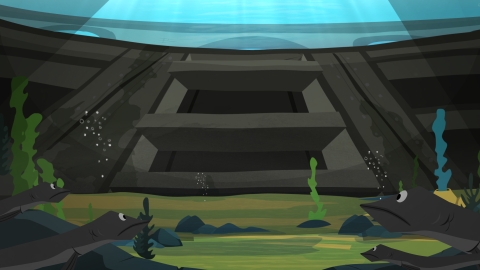Big Five conservation measures for diadromous fish
Five years of fish tracking research using the LifeWatch fish acoustic receiver network has generated key insights in how to save diadromous fish species from historically low numbers.

The populations of diadromous fish species reached historical low abundances. Diadromous fish species are fish that migrate between the sea and rivers to complete their lifecycle, such as salmons, which spawn in rivers, but grow at sea. Or eels, which do the exact opposite. However, due to water regulating obstacles in rivers like dams, hydropower stations and sluices, their migration is blocked. On top of that, many rivers have been degraded substantially by human activities, such as pollution and changes in water flow, leading to the disappearance of essential spawning and growing habitats.
Researchers from Ghent University (UGent), Flanders Marine Institute (VLIZ) and the Research Institute for Nature and Forest (INBO) formulated five major actions (the ‘Big Five’) that need to be considered to restore diadromous fish populations. First, it should be checked if a migration barrier is still of use and whether it can be removed or not. Secondly, if a barrier can’t be removed, it should be adjusted in such a way to make the passage of fish possible, both in an upstream and downstream direction. This can be achieved by the construction of, for instance, fish passes, a temporal barrier management (opening the barrier during fish migration) or the replacement of fish-killing hydropower turbines by fish-safe alternatives. In the third place, the spawning and growing habitat needs to be restored. Obviously, it is not only important to open the door for migratory fish, it is crucial as well that the habitat they are migrating to is in a good state. When these aspects are fulfilled, recolonization and restoration of the targeted diadromous fish species could be possible. However, in specific cases restocking with juvenile fish from a nearby population (consideration four) may be desirable. Restocking can be crucial, for instance, if there is no ‘source’ population that could colonize the river. Finally, when a population is restored, sustainable fishing on the economic relevant species may resume.
Obviously, it is impossible to apply these ‘Big Five’ measures to every river. Therefore, the LifeWatch researchers recommend to apply these considerations to carefully chosen rivers, or river stretches, and develop river nature reserves; river protected areas as you want. Nature reserves are a well-known concept in the terrestrial and marine environment, but not yet within riverine systems. Time to make a change!
Read the whole article here.
For more info about the difficult migration of the eel, a diadromous species:
Image credit: VLIZ
Researchers from Ghent University (UGent), Flanders Marine Institute (VLIZ) and the Research Institute for Nature and Forest (INBO) formulated five major actions (the ‘Big Five’) that need to be considered to restore diadromous fish populations. First, it should be checked if a migration barrier is still of use and whether it can be removed or not. Secondly, if a barrier can’t be removed, it should be adjusted in such a way to make the passage of fish possible, both in an upstream and downstream direction. This can be achieved by the construction of, for instance, fish passes, a temporal barrier management (opening the barrier during fish migration) or the replacement of fish-killing hydropower turbines by fish-safe alternatives. In the third place, the spawning and growing habitat needs to be restored. Obviously, it is not only important to open the door for migratory fish, it is crucial as well that the habitat they are migrating to is in a good state. When these aspects are fulfilled, recolonization and restoration of the targeted diadromous fish species could be possible. However, in specific cases restocking with juvenile fish from a nearby population (consideration four) may be desirable. Restocking can be crucial, for instance, if there is no ‘source’ population that could colonize the river. Finally, when a population is restored, sustainable fishing on the economic relevant species may resume.
Obviously, it is impossible to apply these ‘Big Five’ measures to every river. Therefore, the LifeWatch researchers recommend to apply these considerations to carefully chosen rivers, or river stretches, and develop river nature reserves; river protected areas as you want. Nature reserves are a well-known concept in the terrestrial and marine environment, but not yet within riverine systems. Time to make a change!
Read the whole article here.
For more info about the difficult migration of the eel, a diadromous species:
Image credit: VLIZ



